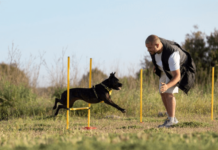Last Updated on January 7, 2023 by Dogs Vets
Training a Dog Without a Leash + Benefits
Training a dog without a leash can be a rewarding and bonding experience for both the dog and the owner.
It allows the dog to have more freedom and allows the owner to have more control over their dog’s behavior.
Here are some steps to follow when training a dog without a leash:
- Start with basic obedience training. This includes commands such as “sit,” “stay,” “come,” and “heel.” These commands will be essential for off-leash training.
- Begin training in a secure, enclosed area. This could be a fenced-in yard or a leash-free park. Make sure the area is free of distractions and that the dog is the only one present.
- Use treats and positive reinforcement to encourage good behavior. Reward the dog with treats and praise when they follow commands and stay close to you.
- Gradually increase the length of time the dog is off-leash. Start with a few minutes and gradually increase the time as the dog becomes more comfortable and reliable.
- Practice recall (the “come” command) frequently. This is one of the most important commands for off-leash training, as it will allow you to regain control of the dog if they wander too far away.
- Gradually introduce distractions. Once the dog is reliable off-leash in a secure, enclosed area, start introducing distractions such as other people or dogs.
- Use a long training leash as a backup. While training, it’s a good idea to have a long training leash as a backup in case the dog gets too far away or becomes distracted.
- Be patient. Off-leash training can take time and requires consistent practice. Be patient with your dog and don’t get discouraged if they don’t progress as quickly as you’d like.
- Use caution when training around traffic. It’s important to always keep the dog’s safety in mind, especially when training around traffic. Make sure the dog is well-trained and reliable before attempting off-leash training in areas with heavy traffic.
- Remember to always supervise your dog when they are off-leash. Even with training, it’s important to always keep an eye on your dog when they are off-leash to ensure their safety.
Benefits of Training Dog Without a Leash
There are several benefits to training a dog without a leash:
- Increased obedience:
When a dog is trained to obey commands without a leash, it means they have a strong foundation in obedience training and are more likely to listen to their owner in any situation. - Greater freedom:
Allowing a dog to roam freely without a leash can give them a greater sense of freedom and allow them to explore and exercise more fully. - Improved socialization:
Leash-free training can help a dog learn to interact with other dogs and people in a more natural way, improving their socialization skills. - Stronger bond with owner:
Training a dog without a leash requires a high level of trust and communication between the dog and owner, which can strengthen the bond between them. - Increased confidence:
When a dog is able to roam freely and make their own decisions, it can increase their confidence and independence.
It’s important to note, however, that leash-free training should only be done in a safe and controlled environment, and it’s essential to make sure that the dog is fully trained and able to obey commands before attempting it.
Q&A
-
Is it safe to train a dog without a leash?
It can be safe to train a dog without a leash, as long as the dog is well-trained and reliable, and the training takes place in a secure, enclosed area.
It’s important to always supervise the dog when they are off-leash and to use caution when training around traffic.
-
Can any breed of dog be trained off-leash?
Most breeds of dogs can be trained off-leash, as long as they are well-trained and reliable.
However, some breeds may be more prone to wandering or chasing after distractions, so it’s important to consider the individual characteristics of your dog when deciding whether off-leash training is appropriate.
-
How long does it take to train a dog off-leash?
The amount of time it takes to train a dog off-leash will vary depending on the individual dog and their level of training.
Some dogs may progress more quickly than others. It’s important to be patient and consistent with training, and to gradually increase the length of time the dog is off-leash as they become more comfortable and reliable.
-
What should I do if my dog doesn’t come when I call them off-leash?
If your dog doesn’t come when you call them off-leash, there are a few things you can try:
- Make sure you have treats or a favorite toy with you to use as a reward when the dog comes.
- Use a high-pitched, excited tone when calling the dog, as this can be more appealing to them.
- Try calling the dog’s name followed by a command, such as “Max, come!”
- If the dog is distracted, try to get their attention by clapping or making a loud noise.
- If the dog still doesn’t come, consider using a long training leash as a backup to regain control of the dog.
-
Is it okay to use punishment when training a dog off-leash?
Punishment is generally not an effective way to train a dog and can lead to negative behaviors such as aggression or fear. It’s best to use positive reinforcement techniques, such as treats and praise, to encourage good behavior.
-
Can I train a dog off-leash if I live in an apartment or don’t have a fenced-in yard?
While it may be more challenging to train a dog off-leash in an apartment or without a fenced-in yard, it is possible.
You can start by training in a secure, enclosed area such as a leash-free park or a fenced-in yard, and gradually increase the length of time the dog is off-leash as they become more reliable.
It’s also a good idea to use a long training leash as a backup in case the dog gets too far away or becomes distracted.
-
How do I introduce distractions when training a dog off-leash?
To introduce distractions when training a dog off-leash, start by adding one distraction at a time.
For example, you could start by introducing another person or dog while the dog is off-leash, and gradually increase the number of distractions as the dog becomes more reliable.
It’s important to remember to reward the dog with treats and praise for good behavior and to stay close to you.
-
How do I know when my dog is ready for off-leash training?
A dog is generally ready for off-leash training when they are well-trained and reliable in basic obedience commands such as “sit,” “stay,” “come,” and “heel.” They should also be comfortable being off-leash in a secure, enclosed area without becoming distracted or wandering too far away.
-
Can off-leash training be dangerous for the dog?
Off-leash training can be dangerous for the dog if it is not done properly. It’s important to always supervise the dog when they are off-leash and to use caution when training around traffic. It’s also a good idea to use a long training leash as a backup in case the dog gets too far away or becomes distracted.
-
How can I make off-leash training a positive experience for both me and my dog?
To make off-leash training a positive experience for both you and your dog, it’s important to be patient and consistent with training, and to use positive reinforcement techniques such as treats and praise to encourage good behavior.
It’s also a good idea to start training in a secure, enclosed area and gradually increase the length of time the dog is off-leash as they become more reliable.
Remember to always supervise the dog when they are off-leash and to use caution when training around traffic.
Fact Check
We hope you enjoyed reading this article. What are your thoughts on the topic?
“At [Dogsvets.com], our goal is to bring you the most accurate and up-to-date information on all things pet-related.
If you have any additional insights or would like to advertise with us, don’t hesitate to get in touch.
If you notice any errors or discrepancies in our content, please let us know so we can correct them.
We welcome your feedback and encourage you to share this article with others.”

















